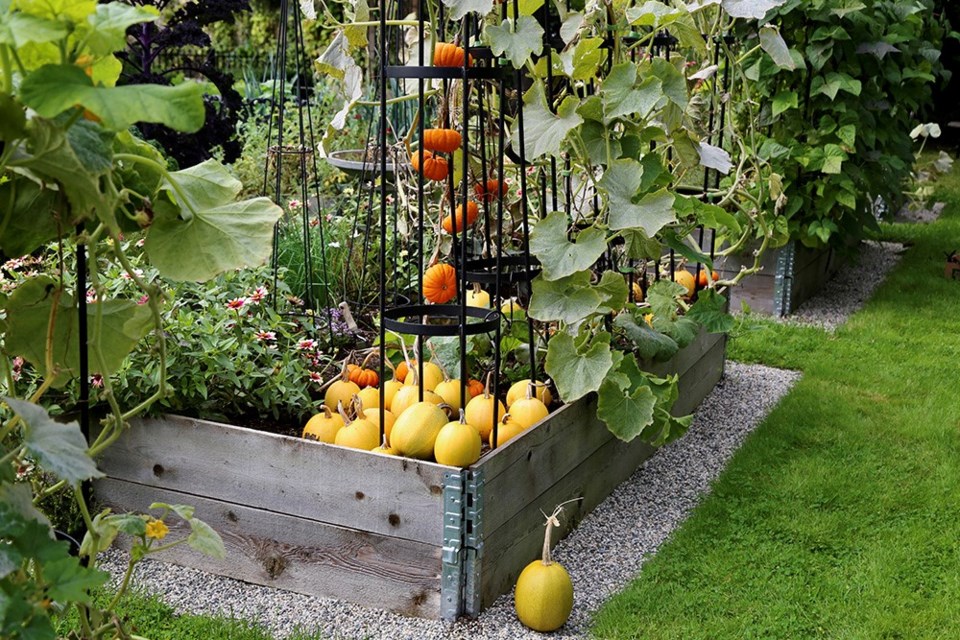I experimented this year with growing several different types of squash and small pumpkins on trellises, to share with clients and readers just how much nutrient-dense cellarable fruit (botanically speaking) one can grow per square foot of garden bed. Would you believe six?
I surprised myself actually, with an impressive yield of 28 Angel Hair spaghettini squash, five Buttercup squash, and 16 Munchkin pumpkins produced on five 1.5 metre-high iron obelisks consuming less than 0.7 square metres of real estate — about one-quarter of a traditional four- by eight-foot raised garden bed.
In an adjacent bed, I planted three similar obelisks with three varieties of Row 7 squash (Centercut, 898 Experimental, and Tetra) that were collaboratively designed by chefs and growers to be harvested and consumed in their infancy, but could also be left to mature for cellaring. I did a bit of both, so while my ROI was truly impressive, I can’t say for sure what it was.
Also, about 10 weeks ago, I mid-season planted a handful of the Row 7 squash seeds, plus a second variety of personal-size spaghetti squash called Small Wonder, in a new edible ecosystem garden built using a hybrid of hugelkultur and lasagna layering principles. These rambling squash grew incredibly quickly, but delivered only five fruit per 0.7 square metre — about 10 per cent of the trellised model.
I really enjoyed trellising the squash, not just for its ROI, but also for its beauty and built-in pest-repelling and soil-mulching growth habits. The large, dense leaves filter the sun to reduce soil temperature, and many veggie munching insects would rather not tangle with the softly but decidedly irritating prickles along the stalks and undersides of some leaves.
Three Sisters garden
These same virtues play a role in the ancient Three Sisters trilogy of corn, beans and squash, in which nitrogen-fixing beans trellis on cornstalks and fertilize both the corn and the squash, whose role is to cool, and defend from predators. Nature is so incredibly clever, as were the Indigenous populations who perfected the ingenious companion planting scenario, practising it throughout the Americas over thousands of years.
Spaghetti squash is considered nutrient-dense because it delivers a high measure of nutrients in relation to the number of calories, on average. Spaghetti squash is a good source of dietary fibre, and it is loaded with antioxidant beta-carotene and vitamin C — two elements that can help reduce risk of cancer and chronic disease. According to Healthline, one cup (155 grams) of cooked spaghetti squash provides 42 calories, 10 g carbs, 2.2 g fibre, one gram protein, 0.5 g fat, nine per cent RDI vitamin C, eight per cent RDI manganese, eight per cent RDI vitamin B6, six per cent RDI pantothenic acid, six per cent RDI niacin, five per cent RDI potassium, plus small amounts of thiamine, magnesium, folate, calcium, and iron.
Pasta alternative
In my kitchen, spaghetti squash offers a great alternative to carbs and traditional pasta noodles. Recently, I served squash "spaghetti" with home-grown mixed herb and walnut pesto as a pasta course to fellow North Shore residents Chef Trevor Bird and his family. At the time of their visit, Trevor and his wife Maria were on a keto diet, and the low-calorie, low-carb squash made meal planning super easy.
I think that Maria may try trellising both squash and cucumber in her own food garden next season.
Garden tip: I planted two squash seedlings at the base of each obelisk upright. Eight plants per obelisk may seem a lot, but given that extreme cold and extreme heat both limit pollinator activity, and/or make squash pollen sticky, hedging your bets by over-planting may be a good idea.
Kitchen tip: to make squash "noodles," cut a spaghetti squash in half lengthwise carefully, remove seeds with a spoon, brush the flesh with olive oil and place the halves cut-side-down on parchment on a rimmed baking sheet or in a suitable pan. Bake at 375°F for about 30 minutes for a medium-size squash — only until al dente, not mushy. Use a fork to tease out the noodles to toss gently with a sauce or add to a power bowl, or simply twist-out the noodles a bit in-place, then drizzle with pesto-infused olive oil. Salt only after cooking, to avoid water draw.
Laura Marie Neubert is a West Vancouver-based urban permaculture designer. Follow her on Instagram @upfrontandbeautiful, learn more about permaculture by visiting her Upfront & Beautiful website or email your questions to her here.
For a taste of permaculture, click on the YouTube link below:
(Video - Courtesy of West Vancouver Memorial Library)




